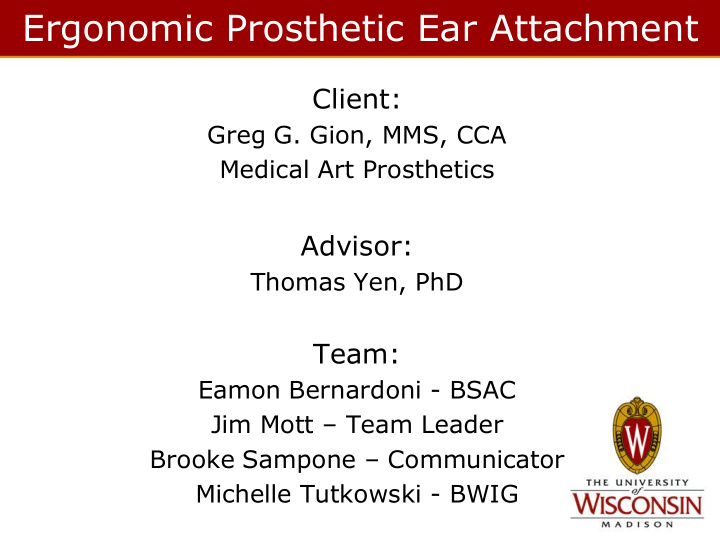



Ergonomic Prosthetic Ear Attachment Client: Greg G. Gion, MMS, CCA Medical Art Prosthetics Advisor: Thomas Yen, PhD Team: Eamon Bernardoni - BSAC Jim Mott – Team Leader Brooke Sampone – Communicator Michelle Tutkowski - BWIG
Outline • Motivation and need for a reliable prosthetic • Market alternatives • Design criteria • Design alternatives • Selection of final design • Testing and obstacles to overcome • Future outlook
The Motivation and Need for a Reliable Ear Prosthesis • Motivation – Observable defects are a source of psychological trauma • Need Figure 1. Child with microtia. – Physical Trauma – Cancer – Microtia • Congenital deformity of outer ear occurring in every 1 of 10,000 births – Certain Syndromes • Malformed/absent outer ear, incomplete development of ear Figure 2. Man with ear trauma.
Market Alternatives • Slip-on prosthesis – Implant not used – Not secure • Magnet-abutment cap techniques – Abutments implanted Figure 3. Slip-on Figure 4. Magnet- perpendicular to bone prosthesis. abutment cap technique. – Attachment not secure • Bar-clip method – Difficult to clean under – Can become loose or get bent – No absolute measure of security Figure 5. Bar-clip method.
Design Criteria • Resists unintentional dislodgement – Withstands anterior and posterior forces • Is low profile • Contained within the prosthesis • Integrates with titanium implants • Requires minimal effort to remove and attach • Fails before bone is damaged • Applies to a variety of abutment orientations and head topographies
Vertical Track Design • Three vertical track attachments in prosthesis • Secured using: – Lips of the track – Gravity – Magnets • Only works in ideal cases Figure 6. Ear with attachments. • Attachment too strong Figure 7. Figure 8. Figure 9. Abutments Attachment back. Attachment front. in patient.
Break Away Options Film Canister Circular Groove Screw in Attachment • Face of attachment • Groove cut in body • Attachment made of snaps into main part of abutment cap weaker material • Can be replaced • Breaks above the • Unscrew and replace when it breaks threads so it can be when it breaks unscrewed
Break Away Matrix Film Circular Screw in Criteria Canister Groove Attachment Cost (10) 7 6 2 Feasibility 11 20 8 (25) Replaceability 16 21 15 (25) Effectiveness 26 35 26 (40) Total 60 82 51
Alignment Options Angled Cylinders Spherical Cap Plate Bone Skin Plate Cap Implants Implant Bone Skin • Caps correct for non- • Tolerates slightly • Potential to work for parallel abutments non-parallel every case • Must be customized abutments • Requires extra for each patient • Does not use material in the head • Does not use commercially commercially available caps available caps
Alignment Matrix Angled Spherical Criteria Plate Cylinders Cap Cost (10) 5 7 2 Feasibility (25) 18 18 6 Effectiveness (25) 10 19 23 Compatibility (40) 36 33 10 Total 69 77 41
Testing of Device • Large scale models – Determine range of applicable angles – Determine assembly fit/quality of fit • SolidWorks Stress Analysis – Different materials • Physical force testing on cap • Physical testing on ear Figure 10. SolidWorks stress analysis.
Where will we go from here? • Finalize cap dimensions and material • 2 nd meeting with WARF • Fabrication – Injection Molding • Alignment of attachment and caps in non-ideal cases • Force testing – Safety breakage – Attachment quality • Reduce attachment visibility – Conceal slot Figure 11. Woman – Reduce size with ear prosthesis.
Questions?
Recommend
More recommend